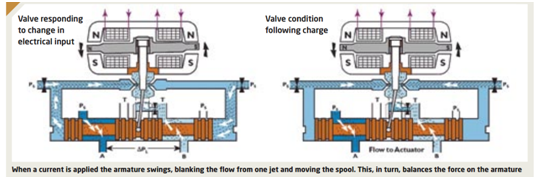When Bill Moog patented his fluid control valve in 1950, it comprised several hydraulic control principles developed over centuries. It was his packaging and refinement, however, that made the Moog fluid control valve such a powerful component.
The clever part of a Moog valve is its ability to precisely control the flow of high-pressure fluids with very small control inputs. The way it achieves this is by using the pressure of the fluid it controls to power the valve.
Moog valve
A Moog valve continuously flows a small amount of fluid through two small jets facing each other. Between them is a flapper valve connected to the armature in a torque motor.
The armature sits between permanent magnets and, as a current is fed to wire coils around the armature, it twists a small amount – a couple of degrees at most.
This, in turn, moves the flapper valve, obstructing the flow from one of the two jets and increasing the pressure in that feed compared with the other, which is still venting pressure through its unrestricted jet.
Both these pressure feeds are connected via a side gallery to either end of a sliding valve, called a spool, in a cylindrical gallery with cut-out valve orifices.
The difference in pressure between the two feed pipes causes the spool to slide along the cylinder, opening a supply of the main pressure feed in the direction required via the ports.

The Moog valve has an additional refinement that gives it its spectacular level of accuracy and control. On the end of the armature-mounted flapper valve is a feedback spring. Put simply, this is a flexible member with a ball end that locates in the spool.
As the spool moves in response to the pressure difference, it moves the end of the feedback spring, opposing the movement of the flapper valve and armature.
At some point, the two opposing forces reach an equilibrium that stabilises the position of the spool and, in turn, the amount of restriction to the main flow of fluid. In this way, it allows small changes to the current at the armature to produce precise changes to the flow of fluid.
This principle allows the Moog valve to also work as a fluid pressure amplifier…